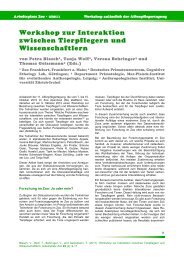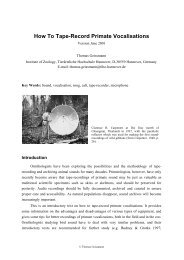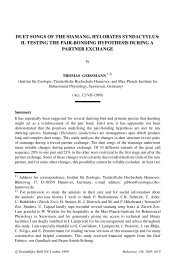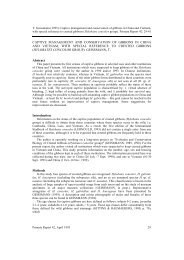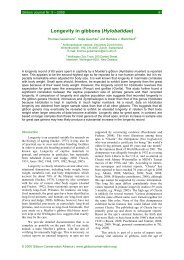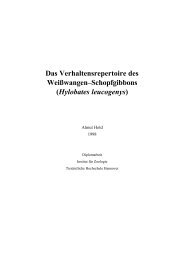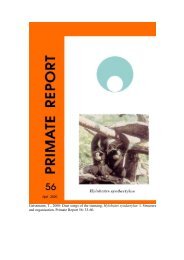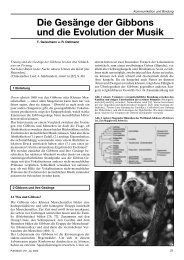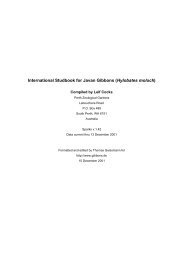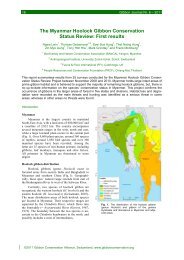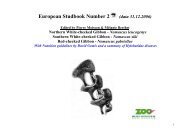The male song of the Javan silvery gibbon (Hylobates moloch)
The male song of the Javan silvery gibbon (Hylobates moloch)
The male song of the Javan silvery gibbon (Hylobates moloch)
- No tags were found...
You also want an ePaper? Increase the reach of your titles
YUMPU automatically turns print PDFs into web optimized ePapers that Google loves.
6 T. Geissmann et al. – <strong>The</strong> Male Song <strong>of</strong> <strong>the</strong> <strong>Javan</strong> Silvery Gibbonfined and described below. Duration andfrequency measurements were taken on threerepresentative notes <strong>of</strong> each note type per individual.Summary measurements (mean, standarddeviation, range) are presented in Table 2. Inaddition, <strong>the</strong> table lists <strong>the</strong> number <strong>of</strong> <strong>gibbon</strong>s and<strong>the</strong> number <strong>of</strong> notes that were available for <strong>the</strong>measurements. Because not all individuals useevery note type in <strong>the</strong>ir <strong>song</strong> bouts, <strong>the</strong> number <strong>of</strong>individuals studied may differ between note typesin <strong>the</strong> table. Typical sonagrams <strong>of</strong> all note typesand classes are shown in Figure 2.Based on <strong>the</strong>ir different mechanisms <strong>of</strong>utterance, we first differentiate between expirationnotes and inspiration notes (i.e. notes which areproduced during exhalation and during breathintake, respectively). As <strong>the</strong>re is no intermediateoption between <strong>the</strong>se two forms <strong>of</strong> vocalisation,<strong>the</strong> two forms cannot, by definition, grade intoeach o<strong>the</strong>r and are, <strong>the</strong>refore, identified as twodifferent note classes. Expiration notes represent<strong>the</strong> large majority <strong>of</strong> <strong>the</strong> <strong>song</strong> repertoire.Expiration notes can be fur<strong>the</strong>r divided in anumber <strong>of</strong> note types. <strong>The</strong>y represent a gradedsystem, and intermediate forms can be foundamong <strong>the</strong> different types. Yet, because someforms are particularly common, we identified<strong>the</strong>m as different note types, although <strong>the</strong>sedivisions remain arbitrary. Based on similarity,expiration note types are combined into four basicgroups: oo notes (1 type), wa notes (4 types),chevron notes (7 types) and variable notes (1type). Only one type <strong>of</strong> inspiration note isrecognised in this study.Oo notes<strong>The</strong> oo notes (Type A) are <strong>the</strong> most simple expirationnotes in <strong>the</strong> <strong>male</strong> <strong>song</strong> repertoire, exhibiting<strong>the</strong> lowest intensity, <strong>the</strong> shortest duration (0.2±0.1s) and <strong>the</strong> smallest amount <strong>of</strong> frequencymodulation (Figure 2). <strong>The</strong> fundamental frequencyis below 1 kHz. Oo notes exhibit only amoderate amount <strong>of</strong> frequency modulation, but<strong>the</strong> note shape in <strong>the</strong> sonagram is very variable:We found oo notes <strong>of</strong> increasing, decreasing orstable frequency. More complex sonagramstructures – such as u-shaped or n-shaped notes ornotes which begin with stable frequency butsharply go down at <strong>the</strong> end <strong>of</strong> <strong>the</strong> note – alsooccur. Oo notes are preferentially uttered at <strong>the</strong>beginning <strong>of</strong> <strong>the</strong> <strong>male</strong> <strong>song</strong> bout, but also occurduring mild disturbances and moderate excitementoutside <strong>of</strong> <strong>the</strong> <strong>song</strong> context.During <strong>song</strong> bouts, notes may gradually changefrom oo notes into wa notes (see below).Wa notesFollowing Kappeler (1984a), <strong>the</strong> most commongroup <strong>of</strong> expiration notes are termed wa notes.<strong>The</strong>y are short like, but louder than, oo notes andcharacterised by a fast frequency increase. Startingfrequency and minimum frequency alwayscoincide in wa notes. After reaching <strong>the</strong> maximumfrequency near <strong>the</strong> end <strong>of</strong> <strong>the</strong> note, a terminalfrequency decrease is absent or slight, amountingto less than half <strong>of</strong> <strong>the</strong> preceding frequencyincrease. Wa notes are very variable in <strong>the</strong>ir endand maximum frequencies. We distinguish betweenfour different note types (Figures 2), whichwe term B1, B2, B3 and B4 in <strong>the</strong> following text.Note type B1 comprises wa notes <strong>of</strong> relativelymoderate frequency modulation. Notes have astarting frequency <strong>of</strong> about 0.7 kHz or below, andreach a maximum frequency <strong>of</strong> 1 kHz or less.Note type B2 resembles B1, but <strong>the</strong> maximumfrequency ranges from above 1 kHz up to 1.3 kHz.Note type B3 comprises <strong>the</strong> wa notes with <strong>the</strong>highest amount <strong>of</strong> frequency modulation. Thisnote type resembles B1, but <strong>the</strong> maximumfrequency ranges from above 1.3 kHz to about 1.5kHz. Note type B4 includes wa notes with arelatively high starting frequency (i.e. above 0.7kHz). <strong>The</strong> maximum frequency is variable and canrise to about 1.5 kHz.<strong>The</strong> trill is a particularly stereotyped figure (i.e.a <strong>song</strong> unit intermediate between single notes andphrases). Trills are short bursts <strong>of</strong> three to five B1notes with very short intervals. Often, <strong>the</strong> trillexhibits a distinct decrease in minimum frequency,maximum frequency and frequency rangefrom <strong>the</strong> first to <strong>the</strong> last trill note. Individual trillnotes may or may not be followed by inspirationnotes (described below). Trills usually are precededby a B2 or B3 note, also with facultativeinspiration note.Chevron notes<strong>The</strong> third group <strong>of</strong> note types comprises thosenotes which have been termed wa-oo and wa-oowanotes by Kappeler (1984 a) and are referred toas chevron notes in <strong>the</strong> present study. Allchevrons begin with rising frequency, <strong>the</strong>n, afterreaching a peak, frequency decreases again.Chevron notes differ in <strong>the</strong>ir frequency structure



